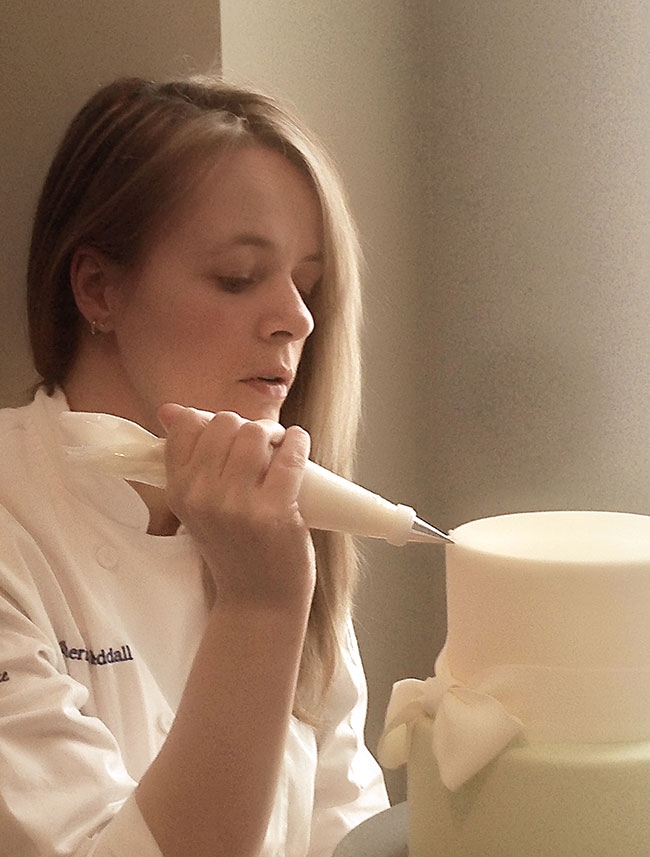
Dream Cakes
April 16, 2015
By Carolyn Camilleri
Three wedding cake innovators discuss trends, techniques and inspiration
 Catherine Bedall Photo Credit: Liz Bedall.
Catherine Bedall Photo Credit: Liz Bedall.When Nina Notaro, owner of Winnipeg’s Cake Studio, laid eyes on her most challenging wedding cake, she got a bit teary-eyed in a happy way. It was delivered to the venue in three sections and, when assembled, measured over five feet, three inches tall.
“That cake was nick-named our royal wedding cake,” she recalls. “Four months of sugar floral work went into that design alone.”
Notaro’s path to cake artistry wasn’t direct. A butcher by trade, she grew up in her family’s grocery store, then owned her own ice cream shop for 15 years before making the shift to pastry.
“I was watching a Food Network special where pastry chefs were working with isomalt sugar. I loved how they could manipulate the molten sugar – like a glass blower – into works of edible art,” she recalls. “I wanted to learn this.”
After a one-year pastry program, Notaro went on to the 2008 IKA Culinary Olympics in Germany, winning gold for Canada in the wedding cake category and bronze in the pastillage category.
Notaro’s creative process usually starts from a style or mood board. She sketches out ideas which coalesce into full-fledged designs.
Sometimes, ideas come from unexpected places: the detail on a handbag, for example.
She describes special techniques as “ah-ha moments” that arrive when she least expects them. Her favourite products? The sugar paste she uses to make the delicate flowers her shop is known for; isomalt sugar with its wonderful transparency; and new products like edible lace.
Notaro has noted a movement toward metallics in wedding cake design, with lots of gold and silver and even bronze and copper tones. Accents of grey, black, navy with lilac and plum are also popular this season, she says.
At her shop, she’s noticed more requests for tall cakes.
“Those show-stopping cakes are making a comeback for us,” Notaro says, adding that she is seeing a decline in cupcake towers and dessert buffets.
That “something special” has also meant an increase in requests for couture flavour profiles. “We are creating flavour combinations like cardamom and orange, rose and almond, apricot and pistachio, lavender and Saskatoon berry, and, my new fave, blueberry with merlot.”
Inclusions are always popular.
“My ice cream background is a definite asset … think blizzard or flurry mix-ins … Skor, Oreo, Smarties, and all those childhood candy and chocolate bar favourites are being used in cake creation for this wedding season.”
Notaro’s advice for others: “Hone your cake skills. Continue to learn from other cake designers, take classes when you can and, most importantly, be critical of your own work. Family and friends are always going to love your cake work. Enter a cake competition or two. There is where you’ll receive a real, honest-to-goodness critique of your work!”
Practice Makes Perfect
Like Notaro, Catherine Beddall, owner of Catherine’s Cakery in Ottawa, took a circuitous route to pastry. She started in journalism school and then transitioned to graphic design for a 13-year stint. Wedding cakes began as a hobby.
“A good friend kindly agreed to let me make her wedding cake, and luckily it turned out quite well, seeing as I had no prior experience or training and no idea what I was doing,” she recalls.
But she was hooked, and started making more celebration and wedding cakes for friends, gaining new customers through word of mouth until it grew into a small business.
“I knew that pastry was my true love, so I decided to say goodbye to my graphic design career and focus on the cakes,” she says.
A decade later, Beddall splits her time between teaching baking and culinary classes and making cakes for clients. Though she doesn’t miss graphic design, she says that experience has helped her immeasurably in all aspects of cake design.
“I have a running list in my head of different designs, colour combinations and themes that I’d love to try, so I don’t think I’ll ever run out of ideas.”
Her preferred creative process is a little unorthodox: instead of sketching on paper, she sketches mentally.
“I’m just more comfortable when I can see my design in my mind’s eye rather than on paper. In my opinion, I produce my best work without ever putting anything down on paper.”
Asked about her favourite products, Beddall doesn’t hesitate.
“I absolutely love Satin Ice fondant – in fact, I’m a product ambassador,” she says proudly.
Butter cream cakes are making a comeback, she says, and while she has seen some beautiful work, she uses fondant for a majority of her cakes, including her stunning ruffled cakes.
She is seeing a trend, though, for naked cakes – layers of cake with butter cream or some other filling and then nothing on the outside, except maybe fruit or flowers.
“Rustic isn’t quite the word … it speaks to the less formal feeling in weddings. It’s a casual look but it can be dressed up,” she says.
She gets fewer requests for big five- and six-tier cakes, and more for smaller cakes surrounded by, for example, French macarons.
She also gets a lot of requests for gluten-free cakes, something she is very comfortable with.
“The gluten-free ingredients available now are very good,” she says. “I notice a slight difference in taste but most people, if you have a good recipe, wouldn’t notice any difference.”
About wedding cakes, Beddall says it is important to do it because you love it and to try not to let it become an onerous chore.
“Keep it an art as opposed to a job, and the way to do that is try not to fill your plate with too many cakes because it is very easy to get burnt out with the hours,” she says. “It is just wonky hours that can get people down after a while.”
Emotion Through Food
The morning before this interview, Daniel Vokey of Patisserie Daniel in Victoria made marzipan roses – 75 or 80 of them – one petal at a time using a spatula. He learned to make these beauties with super-thin petals when he was in his 20s, working at his first job at a Montreal bakery where everything was made from scratch.
After six or eight months of practice, he started experimenting with tones and layers, perfecting what would become his trademark. Though he has been using the same marzipan recipe for 30 years, he still enjoys experimenting.
“I have gone through thousands of pounds of marzipan and fondant and chocolate, and I always try to find a new way to make it interesting,” he says.
He focuses on what he likes to do – and he likes making wedding cakes.
“I think what tends to happen in the baking industry, a lot people don’t want to do wedding cakes – either they are a bakery and they don’t do wedding cakes or if they do, they make it exorbitant,” he says, adding that he is not talking about all bakeries.
“I think sometimes people complicate them – there is a lot of stress about a wedding cake – but a birthday cake is just as important,” he says. “If they don’t like your birthday cake, they won’t come and see you about a wedding cake.”
Vokey views the wedding cake as the first step in a long relationship and places a great deal of importance on meetings with the client and making them feel part of the process. For example, he might prepare three samples of robin’s-egg blue so they can choose exactly what they want. It is the opposite of cookie-cutter cakes. Customers feel good about the attention and they know he cares.
The benefit for him? Loyal customers who tell their friends.
“We have to look beyond the cake – there are anniversaries, birthdays. I have done cakes for the grandchildren of customers,” he says. “I am thinking long-term.”
Vokey favours simplicity and perfect skills and advises not trying things out for the first time on a wedding cake.
“It is better to keep it simple and clean and practice the craft than actually get so stressed out about it,” he says.
While he says fondant and marzipan can be used equally, he prefers marzipan because he likes the flavour. He also loves meringue; he prevents meringue from weeping by stabilizing it with gelatin.
“You can pipe it just as high and thick as you want and then torch it,” he says. “And it is not expensive – it’s egg whites.”
As far as trends, he says they have all kinds of couples now and sometimes they want cakes that aren’t too fluffy or have a different flair.
This year, he is expecting to see more wedding pies – a growing trend on the West Coast that he likes, especially when they look like pies and have a decorative indication of the filling, like cherries or apple slices.
Vokey loves finding ways to make things better and more beautiful, while never losing sight of the significance of each cake for customers.
“When you can do something beautiful … if we celebrate and make everything important … it’s emotion through food – and people get it,” he says. “It enriches. You share. It makes my day.”
Print this page



Leave a Reply